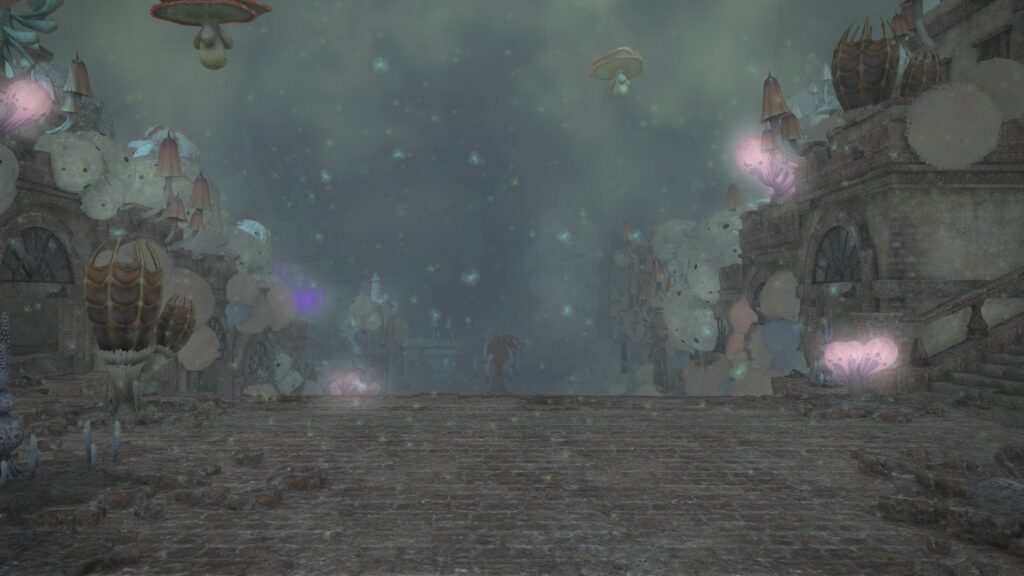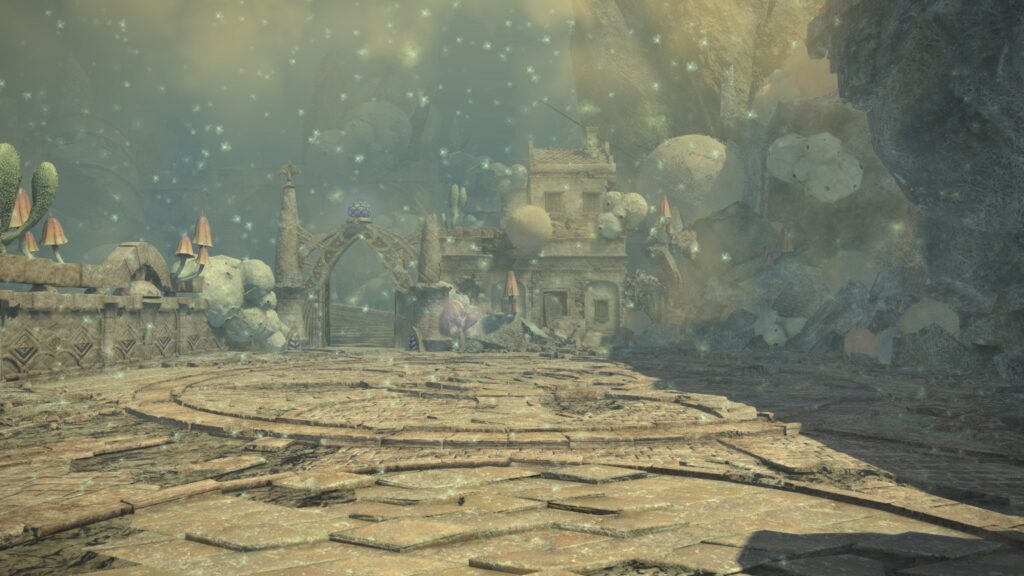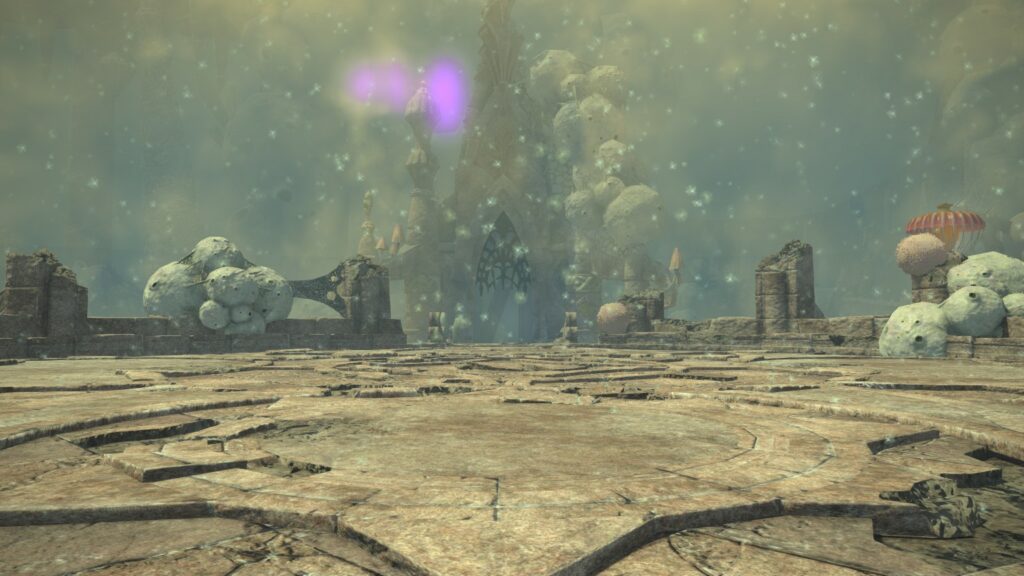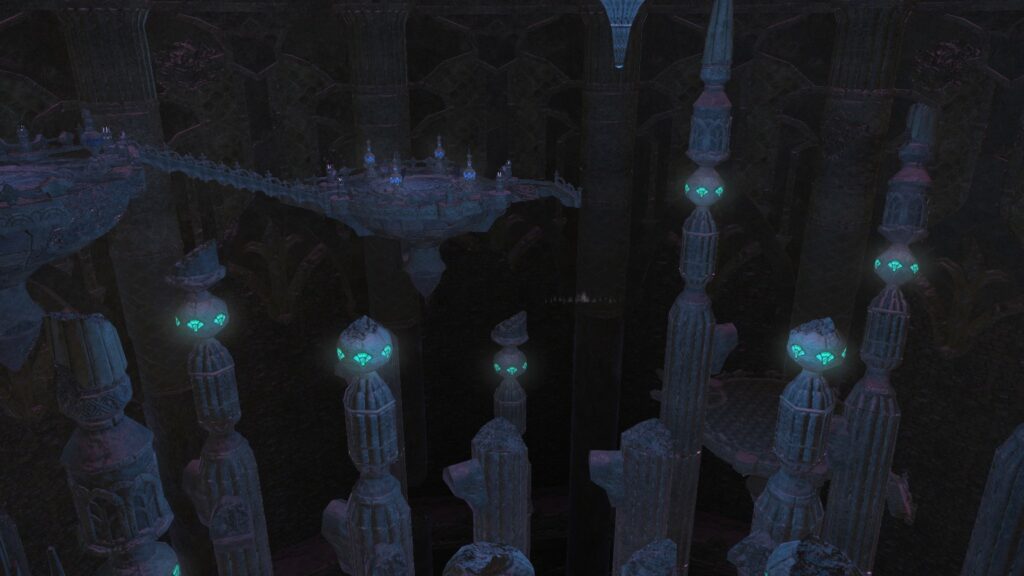Excerpt from ‘The history of the Black Shroud, from Amdapor to Gridania’ by Archon Niniri Niri.
Please refer to the entry on Amdapor Keep for further history on the city-state of Amdapor.
In the wake of the fall of Amdapor Keep, the Amdapori capital was left open to the roving voidsent army of the Mhachi. Thus did the forces of Mhach implement the final part of their invasion plan, summoning a grand noble of the voidsent who went by the name Diabolos. Though the Mhachi were mighty in their magical strength, and their voidsent servants were innumerable and powerful in their own right, they had underestimated the centuries of preparation undertaken by the Amdapori and the strength of their magics. As the dark armies of Mhach approached the city, the Amdapori mobilized their own masses of soulkin, their stone legions battling the voidsent of Mhach while Amdapor’s greatest white mages sealed away Diabolos deep within their city. The Amdapori eventually won the day, though any victory claimed by the residents of the late Fifth Astral era was far too late and rang hollow, as the aetherial balance of the realm had been unbalanced terminally already and so the waters were rising in preparation for the Calamity of Water.
The Amdapori eventually joined with their fellow city states to found one of the Grand Companies of that era, emergency forces constructed in order to properly defend the civilians of Eorzea from the coming flood. The solution found by Amdapor was a simpler one than the grand aetherial shield and highland shelters of Nym, or the immense ark of Mhach. They chose to complete a militarized evacuation, fleeing their homeland to seek refuge in the solace of Gyr Abania. As tidal waves swept in to ravage the coasts and rivers broke their banks to flood the inland regions, the elementals resolved to deny any mortals the chance to recover the white magics of Amdapor that contributed so to the harm of the land. They wove their primordial influence, shrouding the city ruins in a thick mass of vegetation and illusion.
The old capital’s wards fell only in the wake of the Seventh Umbral Calamity, when the colossal destruction released by Dalamud’s fall and Bahamut’s brief awakening weakened its seal. In the wake of this unravelling however, the dire deficit of earth aether resulted in an burst of fungal growth throughout the city, devouring the plantlife that had dominated the ruins and threatening to spread throughout the Shroud if not remedied.
The Entryway
The ancient city was entered via a method that clearly demonstrated the nature of Amdapor as a city that worshipped Nophica, patron of plantlife, as the entrance seems to have been an immense tree with a large gate built into it. The city must have been beautiful once, with terraced walls of the same signature pale stone that the city was famed for framing a modestly sized square at the entry, terminating in an ornately crafted gate. Both the metalwork and stonework of the gate evoked vegetative imagery, in flowing curves and lines. Unfortunately, the fungal growths prompted by the earth aether deficit in the ruins had overtaken the area by the time the team arrived, and were the larger growths weren’t, spreading networks of mycelia stood dominant. Even the air of the city was choked with spores.
Outside of the square was a large staircase affording a view of the white stone houses that once housed an entire civilization, since left to molder. Despite the battle of Amdapor and the predations of both time and mold, the glass windows of many of the houses stood unbroken and racks of amphora littered some of the more ruined houses, clearly demonstrating the abrupt abandonment of the city.

The Agora
A wide pathway framed by buildings that were likely shops or stalls, open-fronted buildings with curved windows atop them, beautiful in their own right. This area was likely a meeting area and center of public discourse for the peace-loving city-state of Amdapor, perhaps acting as a political heartland for the state.
An agora was an area in the ancient city-states of Greece that were the centers of the athletic, artistic and political life in the cities, and just like the Agora of Amdapor the areas, often public squares, were fringed by stalls and shops ran by the craftsmen of the city-state. The most famous legacy of the agoras was the debates that took part in the space, a key part of the democratic processes of these states.

The Halcyon Court
A large courtyard centered on a relief on the floor that seems to depict a symbol which may be a spoked wheel, a sun or most likely, a flower, in keeping with the plant motif maintained by Amdapor. Some archaeologists theorize that this may have been intended as a site of reminiscence or remembrance.
Alcyone, commonly translated as Halcyon, was the princess of Aeolia in Anatolia and wife of Ceyx, the son of the morning star. They referred to each other as “Zeus” and “Hera” affectionately, which drove Zeus to slay Ceyx at sea. When his soul told his wife of this fact she threw herself into the sea and the remorseful gods reincarnated them as Halcyon birds. Alcyone chose to nest on a beach, and her father (a wind god) restrained the winds, granting her seven days each winter where no storms brew. These days have since become known as the Halcyon days, and are used as a term for a time in the past remembered as happy.

The Inner City
Deeper within the city, the residential districts seemed to fade away to a wider area of high-rise towers, suspended walkways and tall aqueducts. Sections of the area had fallen into the abyss below, although some of the lost pathways were bridged instead by thick walkways of fungal growth. The buildings within the inner city were larger than one might expect a house to be, and some contained large ornate stone doors festooned with the floral imagery of Nophica, perhaps suggesting a role as public buildings or even temples.

The Tower of White
Only very little exploration of the Tower of White was possible sadly, as only the roof of the tower was accessible during the initial survey of the city and what was present on the roof was extensively damaged. Two symbols decorated the roof of the tower, a moon and a sun, not particularly images that one would associate with Amdapor but that may hold some significance to their respect for, and worship of, the natural order of things and Nophica. The tower connected directly to the Sanctum of Dreams via a bridge. The pillars surrounding the end of said bridge contained metallic badges illustrated with a plant-like symbol, likely that of Nophica in that age. The significance of the tower is currently unclear, as Amdapor was famed for both its white stone and its white mages, and it may apply to either of these. It could have been an academy for white mages or a center of their order, as we do know that white mages held conclaves to decide on matters relating to their abilities, such as casting off the ‘cure, cura, curaga, curaja’ naming scheme to prefer ‘cure, cure I, Cure II, Cure III’.

The Arrested Darkness and the Sanctum of Dreams
A simply immense tower, the Sanctum of Dreams consisted of a large number of platforms descending into the depths of the tower. Enchantments ensured that the tower remained accessible, as collapsed bridges were replaced by magical pathways. A large, tapered pillar descending from the ceiling evidently contained large stores of aether, and smaller pillars jutting upwards do the same, seemingly containing smaller amounts of the aether. It is unclear what role the Sanctum originally fulfilled, although the name may imply that it was a place of introspection or meditation, although it since became the prison of the mighty voidsent, Diabolos, as referenced by the name Arrested Darkness.

The Waking Nightmare
At the very base of the tower, or at least its explorable regions, was a large magical platform. This magic, as well as the paths found further up, is decorated with nature motifs like much of the city, likely a further reference to Nophica. The name of the platform, coined by those who cleansed the city, was a reference to the Sanctum of Dreams and the blighted nightmare that the voidsent had inflicted upon the tower.





Leave a Reply